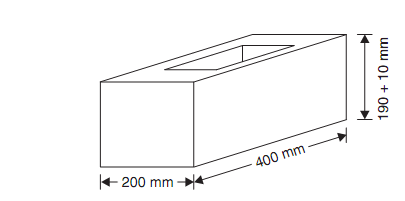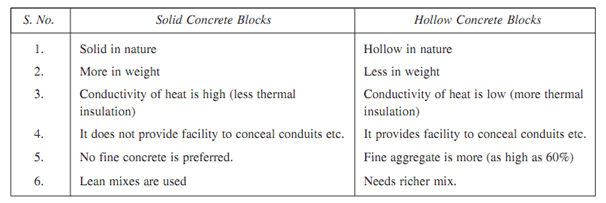SOLID AND HOLLOW CONCRETE BLOCKS
In cities and towns Solid and hollow concrete blocks are manufactured in factories to meet the requirements of building blocks. These blocks can be called as artificial stones, as in the masonry construction they replace the stones. They are composed with lean mixes of cement, sand and aggregate of sizes less than 12 mm. round aggregates are professed Instead of sharp edged aggregates, in the manufacture of these blocks. In this article the properties and uses of these blocks is given
(i) Solid Concrete Blocks: Solid concrete blocks of size 400 mm × 200 mm × 150 mm are generally manufactured. No fine concretes are preferred to reduce the weight of the block. In which fine aggregate is not used, No fine concrete is concrete but round aggregates size is less than 12 mm are used. IS:2185 (part I) In the year 1983 covers the requirement, for such blocks.
The blocks might satisfy the strength requirement of 4 N/mm2. Their density should be keep as low as possible, so that handling is not hard. They might have sharp edges which are at right angles to each other.These blocks are used for load closing wall construction also.
(ii) Hollow Concrete Blocks: they may be made hollow to reduce the weight of concrete blocks, as shown in given page. Hollow blocks of sizes 400 mm × 200 mm × 190 mm (nominal size 400 × 200 ×200 mm) and also of sizes 400 mm × 300 mm × 190 mm (nominal size 400 × 300 × 200 mm) are manufactured. IS:2185 (part I) in the year 1983 covers the specifications for these blocks.
These blocks require richer mixes. Fine aggregates upto 60% and coarse aggregates upto 40% are utilized.

Hollow concrete block
These blocks might also satisfy the strength requirement of 4 N/mm2. They might have truly right angled corners.
Advantage of using concrete blocks is that the construction activity is quick. For finishing the surface Mortar requirement is less. In other words Pointing alone is sufficient, plastering is not necessary. Described table gives the differences between solid and hollow concrete blocks.

Both and hollow and solid blocks can be used for the construction of load bearing as well as partition walls. For the construction of compound walls, they are ideally suited.